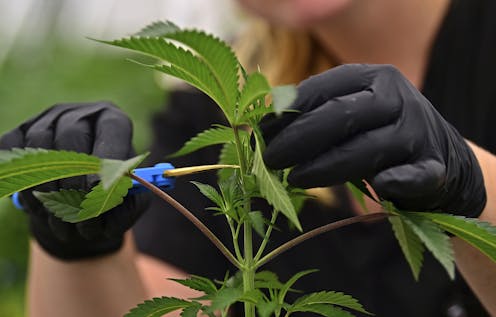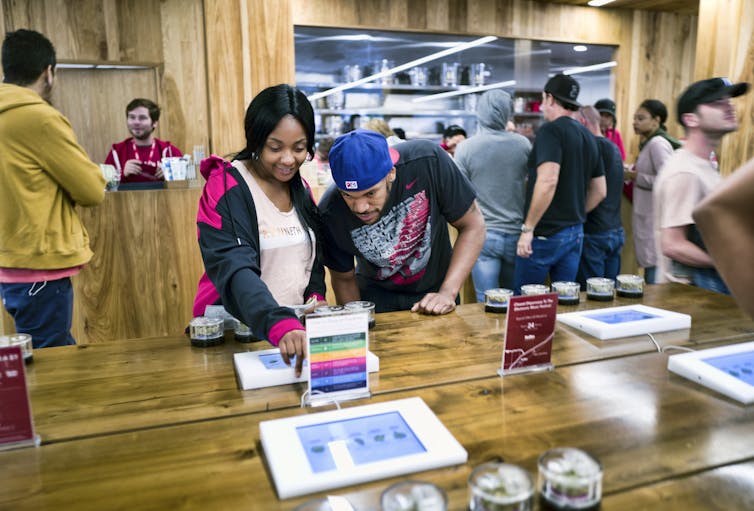Marijuana expands into 3 more states, but nationwide legalization still unlikely
Two-thirds of all US states now have some kind of legal pot, and support for legalization has never been higher. But ballot initiatives can only take legalization so far, researchers say.

The midterm elections have further loosened marijuana restrictions in the United States. Voters in three of four states with ballot proposals on marijuana approved those initiatives.
In Utah and Missouri, voters on Tuesday decided that patients should have access to medical marijuana.
Michigan, which already had medical marijuana, became the first Midwestern state to fully legalize pot. It joins nine other U.S. states, Washington, D.C., Canada and Uruguay in launching a regulated recreational marijuana market.
North Dakotans decisively rejected a proposal to make marijuana legal for recreational purposes.
Before Tuesday’s vote, 22 American states had adopted comprehensive medical marijuana programs. California was the first, recognizing in 1996 the therapeutic uses of marijuana in easing the symptoms of serious illnesses like HIV, cancer, epilepsy, PTSD and glaucoma. Recently, marijuana’s potential value for treating chronic pain has garnered attention as an alternative to opioids.
No tipping point
Nationally, support for marijuana has never been stronger. Seventy-two percent of Democrats and a narrow majority of Republicans – 51 percent – support legalization, according to Gallup.
Strong public support and successive waves of state-level legalization in election years have led many policy analysts to argue that marijuana has reached a tipping point in the United States.
Two-thirds of all U.S. states have now legalized some kind of marijuana. After that, the argument goes, its nationwide expansion is inevitable.
As marijuana policy researchers, we question that narrative.
Our research indicates that medical marijuana progress may well stall after this latest round of successful ballot initiatives. Recreational marijuana may continue to expand into states with legal medical marijuana but will ultimately hit a wall, too.
Our caution has to do with the particular way marijuana legalization has occurred in the United States: at the ballot box.
Ballot initiatives have power
So far, all but one of the recreational marijuana laws passed has occurred via ballot initiative, not through the state legislative process. Seven of the first eight medical marijuana laws – those in California, Alaska, Oregon, Washington, Maine and Nevada – were also adopted via ballot initiative.
Such direct initiatives – where citizens can put a policy on the ballot for approval – are a powerful, if nontraditional, form of policymaking in the United States.
Rather than relying on lawmakers to write and pass legislation on certain issues – often, controversial ones – ballot initiatives harness public opinion. They have been used to legalize or restrict same-sex marriage, place limitations on taxing and spending, raise the minimum wage and much more. Some are funded by wealthy individuals with specific business interests.

Even in states where ballot initiatives have little hope of passing, they can be an important force for policy change.
In Ohio, marijuana advocates in 2015 spent over US$20 million in an effort to legalize both medical and recreational marijuana in the same ballot initiative. Ohio voters overwhelmingly said no – but the campaign revealed broad support for a medical marijuana policy.
The Marijuana Policy Project, an advocacy organization, said it would put medical marijuana on Ohio’s ballot in 2016. In response, Ohio’s legislature moved quickly to craft and pass its own medical marijuana legislation.
In Utah, where Gov. Gary Herbert opposed the expansive medical marijuana proposal passed on Tuesday, lawmakers have already promised to supercede the initiative and pass marijuana legislation that would be more acceptable to conservative state legislators and the influential Mormon Church.
The limits of direct initiative
So the ballot initiative is powerful. But our analysis suggests its potential for liberalizing marijuana access in the U.S. is nearly tapped out.
Of the 17 U.S. states that still have no form of legal marijuana, only five – Idaho, Wyoming, South Dakota, Nebraska and Missouri – allow direct initiatives.
The rest are mostly conservative places like South Carolina and Alabama, where legislatures have indicated reluctance to loosen restrictions. If voters there wanted medical or recreational marijuana, they would not have the option of bypassing policymakers to get the issue on the ballot.
Marijuana legalization won’t end with the 2018 midterms. There is still room for recreational marijuana to expand into the 22 – soon to be 24 – states that have legal medicinal marijuana.
History shows that once people grow comfortable with medical marijuana – seeing its impacts on patients and tax revenues – full legalization often follows.

In our analysis, the remaining 13 states are very unlikely to liberalize access to marijuana without a significant push by the federal government.
That’s unlikely, but not impossible, under the Trump administration.
Federal law still considers marijuana an illegal Schedule I drug under the Controlled Substances Act, meaning that as far as the U.S. government is concerned, the plant has no medical value.
The Obama administration took a hands-off approach to states’ legalization, allowing them to experiment. But Attorney General Jeff Sessions has directed Justice Department attorneys to fully enforce federal law in legal marijuana states.
Quietly, however, the Trump administration has also sought public comments on reclassifying marijuana. And the president himself has at times signaled support for leaving marijuana up to the states.
If Sessions leaves the Trump administration, as rumor has long suggested, the DOJ’s position on marijuana enforcement could change.
And Democrats, who won control of the House on Tuesday, have previously indicated that they could push to remove marijuana as a Schedule I drug as soon as next year.
This article is an updated version of a story originally published on Oct. 31, 2018.
The authors do not work for, consult, own shares in or receive funding from any company or organization that would benefit from this article, and have disclosed no relevant affiliations beyond their academic appointment.
Read These Next
5 scenarios for a post-Maduro Venezuela — and what they could signal to the wider region
President Donald Trump has said the US will ‘run’ Venezuela until a ‘safe, proper and judicious…
A predawn op in Latin America? The US has been here before, but the seizure of Venezuela’s Maduro is
The operation in Venezuela has echoes of Panama in 1989. But in ordering President Maduro’s capture,…
I wrote a book on the politics of war powers, and Trump’s attack on Venezuela reflects Congress surr
Congress has a legal, constitutional and even moral responsibility to assert itself as a branch when…






